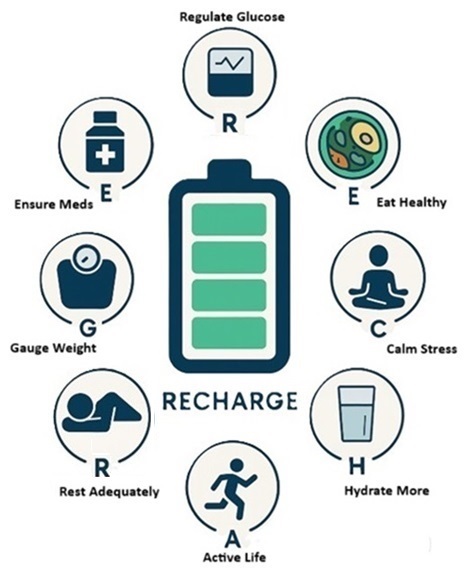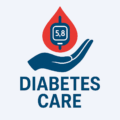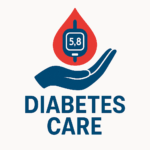Diabetes Lifestyle
RECHARGE: Lifestyle Transformation
R - Regulate Glucose
Active glucose monitoring for better A1C control.
E - Eat Healthy
Eat low carb, low GI diet for better glucose control.
C - Calm Stress
Reduce stress for better blood glucose control.
H - Hydrate More
Stay hydrated for better blood glucose control.

A - Active Life
Exercise for blood glucose control.
R - Rest Adequately
Sleep well to heal and rejuvenate.
G - Gauge Weight
Stay in healthy weight limits for better glucose control.
E - Ensure Meds
Consult your doctor for right meds.
HEALTHY BLOOD GLUCOSE
🔋RECHARGE framework overview
The significant A1C reduction outlined in our featured blog, is the result of a remarkable lifestyle transformation. This transformation is enabled by a framework best represented as the RECHARGE lifestyle transformation. The GetDiabetesCare.com platform is sharing this powerful personal experience in the spirit of sparking such transformation in others who may also benefit from this simple yet powerful lifestyle transformation to beat diabetes and lead healthier lives.
| Action | Impact |
| R – Regulate Glucose | Monitor blood glucose levels regularly using CGM technology to track patterns for better glucose control. |
| E – Eat Healthy | Eat balanced, low carb, high fiber, low Glycemic Index (GI) diet for better glucose control. |
| C – Calm Stress | Calm your mind with relaxation techniques. Stress hormones like cortisol raises blood glucose. |
| H – Hydrate More | Stay hydrated to support metabolism and good glucose control. |
| A – Active Life | Live an active life with regular moderate intensity exercise for good glucose control. |
| R – Rest Adequately | Sleep well to heal and rejuvenate. Poor sleep negatively impacts glucose control. |
| G – Gauge Weight | Track weight to stay within healthy limits to allow better glucose control. |
| E – Ensure Meds | Consult a doctor for the right meds, ensure timely meds for optimal glucose control. |
It is important to note that a permanent lifestyle transformation is key to sustainable health outcomes. Continuous review of each element of the RECHARGE framework ensures a HEALTHY mindset to stay focused on diabetes control. An easy checklist to follow this methodology is available on the link below:
RECHARGE framework details
R - Regulate Glucose
Healthy Blood Sugar Levels
Monitoring blood glucose is the cornerstone of diabetes management. Blood glucose levels give you a real-time picture of how your body is handling sugar. Tracking blood glucose to healthy range helps guide lifestyle changes, treatment decisions, and prevents acute blood sugar emergencies.
Why Monitor Diabetes?
- Understand how food, exercise, stress, and medication affect blood sugar.
- Prevent hyperglycemia (high sugar) and hypoglycemia (low sugar) emergencies.
- Support decisions about life style changes and medication.
- Detect trends and avoid long-term health complications.
How to Monitor Diabetes?
- Self Monitoring using glucometer.
- Continuous Glucose Monitoring (CGM) with CGM sensor and Smartphone App.
- Hemoglobin A1C Test at a Lab.
What are healthy glucose levels?
| Test Type | Normal | Prediabetes | Diabetes |
| Fasting (8+ hrs) | 70–99 mg/dL | 100–125 mg/dL | 126 mg/dL or higher |
| Post-Meal (2 hrs) | < 140 mg/dL | 140–199 mg/dL | 200 mg/dL or higher |
| A1C (3-month average) | < 5.7% | 5.7–6.4% | 6.5% or higher |
To estimate A1C % based on glucose level (mg/dL), use the calculator here.
Use CGM for real time blood glucose monitoring
Harness the power of Continuous Glucose Monitoring (CGM) to gain real-time diabetes insights, empowering smarter lifestyle choices that prevent complications, reduce medication reliance, and support lasting health transformation. This is the foundational component of the RECHARGE transformation methodology.
CGM sensors connected to your smartphone provides real-time feedback on how your body responds to food, movement, stress, and rest, empowering you to make smarter, more personalized decisions every day. By seeing how your glucose levels rise or fall after specific meals or activities, you gain immediate insight into what helps or hinders your blood sugar control. With CGM, you can:
- Optimize your diet by identifying which foods cause spikes or dips in blood sugar, enabling you to choose balanced, low-GI meals that keep your levels steady.
- Time your exercise effectively, as you learn how different types and durations of activity impact your glucose and adjust your routine to maximize benefits while avoiding lows.
- Adjust sleep and stress management habits by seeing how poor rest or elevated stress levels affect your glucose, prompting healthier sleep routines and mindfulness practices.
- Reduce guesswork and enhance motivation by turning invisible patterns into visible insights making it easier to stay consistent and confident in your daily choices.
Action: Leverage CGM to take charge of A1C
Real-time blood glucose insights using CGM allow you to adjust factors like diet and exercise not only to improve day-to-day blood sugar control but also support long-term outcomes like lower A1C, fewer complications, and reduced dependence on medications. CGM transforms diabetes from a hidden struggle into a data-driven, proactive lifestyle helping you live with more control, clarity, and confidence.
E - Eat Healthy
Thoughtful Diet Management
Diet has the potential to make the most significant impact on Diabetes management. A diabetes-friendly diet focuses on controlling blood sugar levels and improving insulin sensitivity. Glycemic Index (GI) is a good indicator to choose the optimal foods for effective glucose control.
Goals:
- Maintain balanced nutrition
- Support a healthy weight
- Improve overall health
Adjust your Diet:
- Reduce portion sizes
- Use the Plate method for a balanced meal: ½ non-starchy veggies, ¼ lean protein, ¼ low carb foods.
- Eat at regular times – don’t skip meals
- Avoid or limit high GI foods
- Hight GI foods include white bread, white rice, sugary drinks and desserts, potato chips, fries, baked goods made with refined flour and processes snacks.
- Choose high-fiber carbs (slows glucose absorption)
- Limit added sugars (read labels!)
- Drink water, not sugary beverages
The Glycemic Index ranks carbohydrates based on how quickly they raise blood glucose.
| GI Range | Classification | Blood Sugar Impact |
|---|---|---|
| 55 or less | Low GI | Slow and steady rise |
| 56–69 | Medium GI | Moderate rise |
| 70 or above | High GI | Fast spike (to be limited) |
Best Foods for a Diabetes Diet (Low GI, high fiber) include:
- Non-Starchy Cruciferous Vegetables: Broccoli, cauliflower, cabbage, Brussels sprouts
- Leafy Vegetables: Spinach, Swiss Chard, kale, lettuce, Collard greens and Mustard greens
- Whole Grains: Steel-cut oats, quinoa, barley, brown rice
- Fruits (in moderation): Apples, oranges, berries, cherries (low GI). Avoid: Watermelon, pineapple (high GI)
- Healthy Fats & Proteins: Nuts, seeds, avocado, fish, chicken, tofu, legumes
- Dairy (low-fat): Greek yogurt, milk, cheese (in moderation)
Action: Fine tune your diet using Glycemic Index
Use Glycemic Index Chart as a guide to choose the right foods to limit glucose spikes and loads. Experiment with different choices to shape your diet for optimal blood glucose control.
C - Calm Stress
Proactive Stress Management
Stress is a natural response to challenges, but chronic stress can harm both physical and mental health especially for people managing conditions like diabetes. Understanding and managing stress begins with self-awareness and continues with practical tools to reduce it.
Stress and diabetes are tightly linked, stress can raise blood sugar levels, make diabetes harder to control, and lead to unhealthy coping habits like poor eating or skipping medication. Recognize the common signs of stress and make sure to manage it so your diabetes stays in control.
How Stress Affects Diabetes
1. Stress Raises Blood Sugar
Stress hormones like cortisol and adrenaline trigger the liver to release glucose for “fight or flight”. This can cause persistent hyperglycemia (high blood sugar)
2. Increases Insulin Resistance
Chronic stress reduces the body’s ability to use insulin effectively
3. Leads to Unhealthy Behaviors
- Emotional eating (especially sugary foods)
- Skipping exercise or medication
Poor sleep, less energy, more fatigue
Signs That Stress Is Affecting Your Diabetes
- Blood sugar is higher than usual without a clear reason
- Frequent fatigue or irritability
- Trouble sleeping or concentrating
- Changes in appetite or exercise habits
Feeling overwhelmed, anxious, or depressed
Ways to Manage Stress for Better Diabetes Control
1. Practice Relaxation Techniques
- Deep breathing, meditation, or mindfulness
- Yoga or tai chi
2. Stay Active
- Exercise lowers stress hormones and improves mood
Even a 20-minute walk can help lower blood sugar and anxiety
3. Build a Routine
Consistent meals, exercise, and sleep patterns reduce unpredictability and stress
4. Connect Socially
- Talk to friends, family, or join a diabetes support group
You’re not alone, sharing helps
5. Set Small, Realistic Goals
- Trying to do too much can cause burnout
Focus on one change at a time
6. Seek Mental Health Support
- Consider therapy or counseling
Depression and anxiety are more common in people with diabetes
Action: Assess & Manage your Stress Levels
Assess you stress level regularly and review impact on blood glucose levels. Utilize relaxations techniques to improve stress levels and monitor impact on blood glucose levels.
H - Hydrate More
The Power of Water
Hydration is a powerful but often overlooked tool in diabetes management. Hydration is crucial for managing diabetes because water supports blood sugar control, kidney function, and overall health. Dehydration can make blood sugar worse and lead to serious complications.
Why Hydration Matters
1. Helps Regulate Blood Sugar
- Water dilutes glucose in the bloodstream
-
Prevents blood from becoming too concentrated during high sugar spikes
2. Supports Kidney Function
- Helps flush excess sugar out through urine
-
Prevents buildup of waste and risk of kidney damage
3. Prevents Dehydration related High Blood Sugar
- High blood sugar pulls fluid from cells → causes more thirst
-
Not drinking enough water worsens dehydration and raises blood sugar further
How Much Water Should Diabetics Drink?
| Age/Condition | Recommended Daily Intake |
|---|---|
| Adults | 8–10 cups (64 – 88 Oz) on average |
| Active or in hot weather | More as needed to compensate for sweat |
| With high blood sugar or taking diuretics | Extra fluids may be necessary |
Action: Drink lots of Water for overall health
Drink at least 8 cups of water to support blood sugar control, reduce complications, and improve quality of life. It’s a vital part of daily self-care routine.
A - Active Life
Moderate Activity is essential
Exercise is not optional, it’s essential for managing diabetes. Exercise is one of the most effective and natural ways to manage, prevent, and improve outcomes for Type 1 and Type 2 diabetes. It helps control blood sugar, improve insulin sensitivity, and reduce complications.
Types of Recommended Exercise
1. Aerobic Exercise
- Examples: Brisk walking, swimming, cycling, dancing
- Aim: 30 mins/day, 5 days/week
2. Resistance (Strength) Training
- Examples: Weight lifting, resistance bands, bodyweight exercises
- Aim: 2–3 times/week
- Helps build muscle and reduce insulin resistance
3. Flexibility and Balance
- Examples: Yoga, tai chi, stretching
- Especially helpful for older adults or those with neuropathy
Benefit | How it Helps |
Improves insulin sensitivity | Helps muscles use glucose more effectively |
Lowers blood sugar | Muscles absorb sugar for energy during exercise |
Supports weight loss | Reduces insulin resistance and risk of Type 2 diabetes |
Boosts heart health | Reduces risk of stroke and cardiovascular disease |
Reduces stress | Lowers cortisol, which can spike blood sugar |
Improves sleep | Better sleep = better glucose control |
Action: Add Moderate Activity to your Schedule
30 minutes of moderate physical activity at least 3 times a week can lower blood sugar, improve insulin sensitivity, support mental well-being, and reduce the risk of long-term complications. It’s never too late to move more and live better.
R - Rest Adequately
Restore & Rejuvenate
Sleep and rest are foundational to managing diabetes effectively. Poor sleep disrupts blood sugar regulation, appetite control, hormone balance, and emotional well-being. Whether you’re newly diagnosed or managing diabetes long-term, improving your sleep can dramatically enhance your quality of life and disease outcomes.
Sleep and diabetes are deeply connected. Poor sleep can raise blood sugar, increase insulin resistance, and make diabetes harder to manage. Likewise, high blood sugar can disturb your sleep.
- Use a sleep monitor to measure your sleep patterns.
- Use a device like an apple watch, aura ring or WHOOP watch to track sleep patterns.
- Strive to meet adequate sleep goals: Light, REM and Deep sleep.
How Sleep Affects Diabetes
1. Poor Sleep Raises Blood Sugar
- Sleep deprivation increases cortisol and growth hormone, both of which raise glucose levels.
Increases insulin resistance, making it harder for your body to lower blood sugar.
2. Less Sleep = More Cravings
- Increases hunger hormones (ghrelin) and reduces fullness hormones (leptin).
Leads to overeating, especially carbs and sugar, bad for blood glucose and weight.
3. Sleep Disorders Are Common in Diabetics
- Sleep apnea, restless legs syndrome (RLS), and insomnia are more common in those with diabetes.
These can worsen blood sugar control and increase the risk of heart disease.
How Diabetes Affects Sleep
| Blood Sugar Issue | Impact on Sleep |
|---|---|
| High sugar (hyperglycemia) | Frequent urination, thirst, headache |
| Low sugar (hypoglycemia) | Night sweats, shaking, nightmares, waking up hungry |
| Neuropathy (nerve pain) | Burning or tingling in legs at night |
| Sleep apnea (often linked to obesity) | Pauses in breathing, daytime fatigue |
Sleep Tips for Better Blood Sugar Control
1. Aim for 7–9 hours/night: Quality and consistency matter
2. Keep a regular sleep schedule: Go to bed and wake up at the same time daily, even on weekends
3. Avoid heavy meals, caffeine, or alcohol before bed: These can spike sugar or disrupt deep sleep
4. Get blood sugar in range before bed: Avoid late high-carb snacks, Check glucose if needed (especially if using insulin)
5. Make your sleep environment calming: Cool, dark, and quiet room, Limit screens (blue light) 1 hour before sleep
6. Manage sleep disorders: If you snore loudly or feel tired despite sleeping, ask your doctor about sleep apnea testing
Action: Sleep well to RECHARGE your body
Prioritize at least 7 hours of sleep / night because a well-rested body is better equipped to regulate blood sugar, respond to insulin, and handle the demands of daily life.
G - Gauge weight
Active Weight Management
Weight is both a cause and a consequence of poor diabetes control. However, it is also one of the most modifiable factors. Whether through lifestyle changes, behavioral support, or medications, losing even a modest amount of weight to reach your BMI goal can dramatically improve blood sugar levels, reduce medication dependence, and lower the risk of complications. Managing your weight can significantly improve blood sugar levels, reduce insulin resistance, and even prevent or reverse Type 2 diabetes in some cases. The BMI table below can help you determine if your weight is in the healthy range. To determine your BMI, use the BMI calculator here:
| Under 18.5 | Underweight |
| 18.5 – 24.9 | Normal |
| 25 – 29.9 | Overweight |
| 30 and over | Obese |
Why Weight Matters in Diabetes
1. Excess body fat = Insulin resistance
Fat, especially around the belly, interferes with insulin’s ability to move glucose into cells.
2. Weight loss improves insulin sensitivity
Losing even 5–10% of body weight can lead to better glucose control and reduced medication needs.
3. Obesity is a major risk factor for Type 2 diabetes
Over 80% of people with Type 2 diabetes are overweight or obese.
Benefits of Weight Loss in Diabetes
| Weight Loss % | Key Improvements |
|---|---|
| 5% | Better blood sugar control |
| 7–10% | Reduced risk of diabetes-related complications |
| 10–15% | May help reverse early Type 2 diabetes |
| 15–20%+ | Can reduce or eliminate some medications |
Weight-Loss Strategies for Diabetics
1. Focus on a Low-Glycemic Diet
- Choose whole foods: vegetables, whole grains, lean protein
Limit sugar, refined carbs, and processed snacks
2. Eat Smaller Portions, More Consistently
- Use the plate method (½ veggies, ¼ protein, ¼ complex carbs)
- Avoid skipping meals, which can lead to overeating
3. Stay Active
- At least 150 minutes/week of moderate exercise
Mix cardio + strength training for best fat loss
4. Hydrate Well
Drinking water helps flush sugar and reduce hunger
5. Get Enough Sleep
Poor sleep increases hunger and insulin resistance
6. Manage Stress
Stress increases cortisol, which raises blood sugar and appetite
Action: Reduce Weight for better Health
Work towards achieving your optimal weight based on BMI and other factors to boosting overall health, including better blood glucose control.
E - Ensure Meds
Optimal Medicine
Diabetes medications are diverse, powerful tools to help manage blood glucose and reduce the risk of complications. The right medication, used at the right time, in the right way, can lead to dramatic improvements in blood sugar, weight, and overall health. However, they are most effective when paired with healthy lifestyle choices and personalized care. Consult your doctor the right meds for optimal blood glucose control.
Types of Diabetes Medications
1. Type 1 Diabetes
Always requires insulin therapy (body produces none)
2. Type 2 Diabetes
May need oral medications, non-insulin injectables, or insulin, depending on progression
Common Medication Categories
| Type | Examples | How They Work |
|---|---|---|
| Insulin | Rapid, regular, long-acting (e.g. Humalog, Lantus) | Replaces or supplements insulin the body lacks |
| Biguanides | Metformin | Reduces liver glucose production & improves insulin sensitivity |
| Sulfonylureas | Glipizide, Glyburide | Stimulate pancreas to release more insulin |
| DPP-4 Inhibitors | Sitagliptin (Januvia), Linagliptin | Help body increase insulin after meals |
| GLP-1 Receptor Agonists | Semaglutide (Ozempic), Liraglutide | Slow digestion, reduce appetite, lower glucose |
| SGLT2 Inhibitors | Empagliflozin (Jardiance), Canagliflozin | Help kidneys remove extra sugar through urine |
| Thiazolidinediones (TZDs) | Pioglitazone (Actos) | Improve insulin sensitivity in fat/muscle |
| Alpha-glucosidase inhibitors | Acarbose | Slow carbohydrate digestion in intestines |
Take as prescribed – don’t skip doses
- Monitor blood sugar regularly
- Report side effects (nausea, dizziness, low sugar)
- Never adjust doses on your own, consult your doctor
- Store insulin properly (avoid extreme heat/cold)
Medication + Lifestyle = Best Results
- Meds don’t replace healthy eating, exercise, sleep, and stress management, they work together.
Action: Consult your doctor for optimal Meds
Work closely with a healthcare provider or diabetes educator to ensure that medication plans evolve alongside your needs and health goals.


